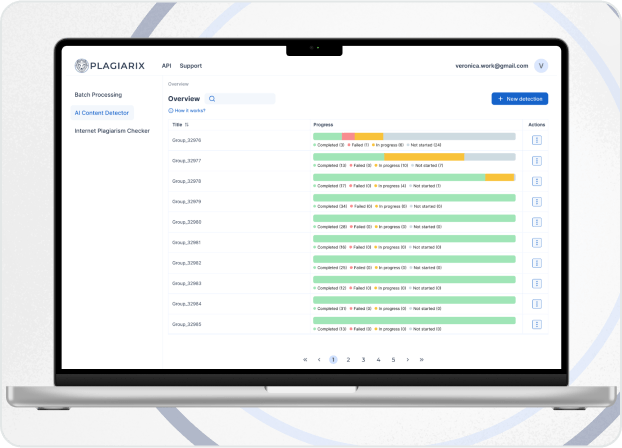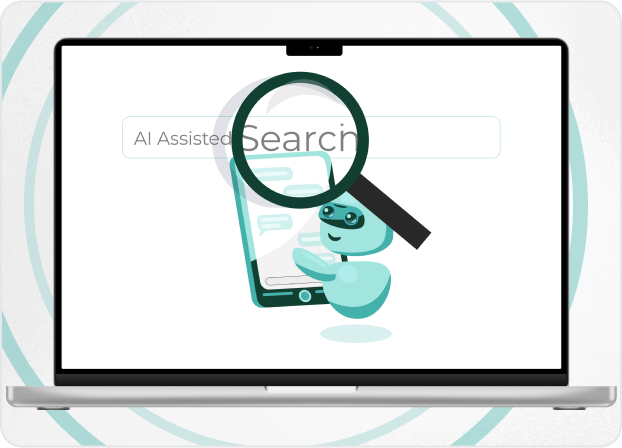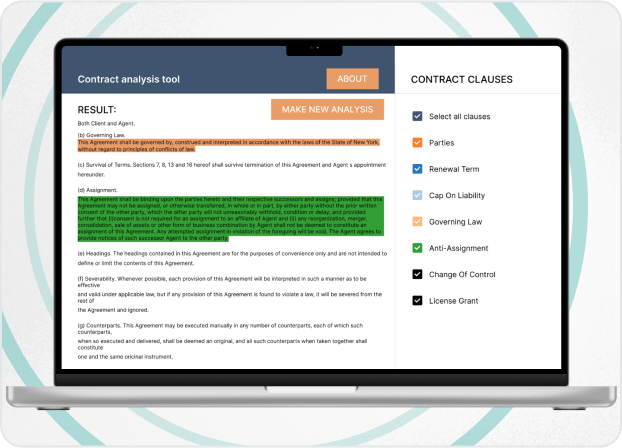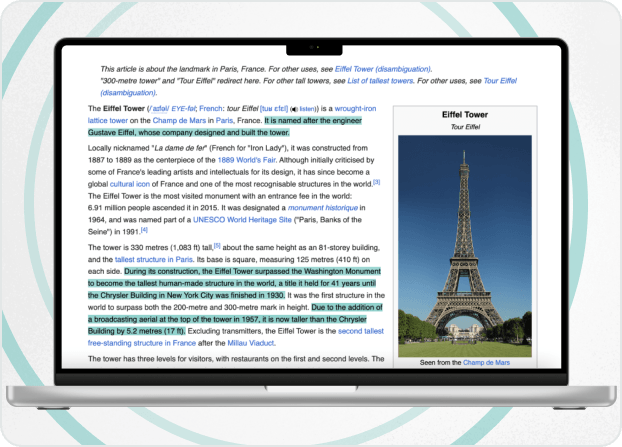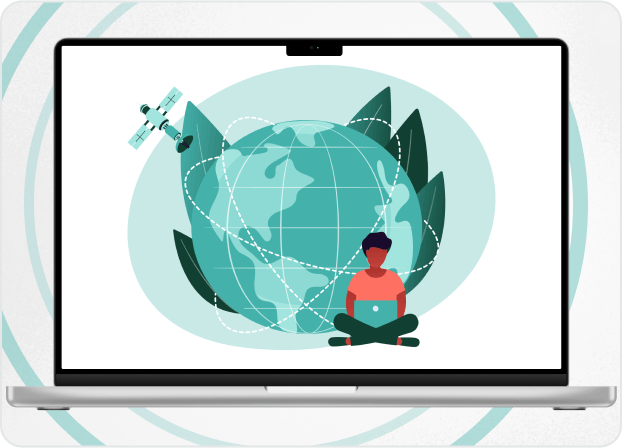
Expert’s Thoughts

"Modern plagiarism detection systems operate at the intersection of computational linguistics and artificial intelligence. By leveraging semantic similarity models, syntactic pattern recognition, and large-scale corpora, these tools detect not just verbatim copying but deeply disguised paraphrasing."
Yuri Svirid, PhD. — CEO Silk Data
How Does a Plagiarism Checker Work?
Plagiarism is a significant challenge in educational, corporate, and publishing environments. AI-powered plagiarism checkers have become the gatekeepers of originality and help educators, publishers, and businesses ensure academic integrity. But how do these tools actually work?
Let's explore current issues in plagiarism detection and focus on how tools integrated into the educational system are attempting to address these complex issues.
Plagiarism and Education: Numbers
- The global anti-plagiarism software market is projected to grow at an annual growth rate (CAGR) of approximately 23.3% from 2023 to 2030.*
- North America holds the largest market share, accounting for about 40% of the global anti-plagiarism software market. This dominance is due to the stringent academic standards in the region. **
Sources:
* Anti-Plagiarism Software Market Size Forecast
** Global Anti Plagiarism Software Market Report
What Does Plagiarism Refer to?
Plagiarism is the act of using someone else’s work, ideas, or content without proper acknowledgment, presenting it as one’s own.
With the rise of neural language models, checking for plagiarism has become a major problem of academic dishonesty and often a threat to the reputation of companies.
Plagiarism isn’t just about copying text word for word — paraphrasing plagiarism is also a thing. Whether done manually or with AI tools, rewording content while keeping the original meaning intact still counts as stealing ideas.
The Problem of Detecting Near Duplicates
Near duplicates are versions or variations of documents that may contain minor changes, additions, or deletions of textual information. Traditional plagiarism detection methods often cannot effectively deal with such cases due to their limited ability and sensitivity to minor changes.
AI tools can analyze not only the structure of text but also its semantic content, making them more sensitive to semantic changes. For example, by implementing a duplicate search system, companies will eliminate the appearance of multiple versions of documents in the document management Systems (DMS) and bring clarity and order to the document flow. Clustering algorithms can group documents with similar content, and classification can help highlight structural and content differences. Legal issues that can arise when checking for modified versions of contracts (due diligence) can also be avoided with this solution.
Where Plagiarism is Most Common

Education
Plagiarism is a significant issue in education, and detection tools are now an integral part of many educational platforms. These tools not only identify copied content but also play a role in teaching students several essential skills like proper research, ethical writing, and correct citation practices.
The problem runs deeper than simple copying. Companies known as "essay mills" (or sometimes “paper mills”) offer pre-written essays or assignments, which students can buy and submit as their own. There have even been claims — though not verified — that some anti-plagiarism services misuse the content they check, reselling it to other customers. This creates a cycle of dishonesty that undermines academic integrity.
Traditional proctoring methods often fail to address the full scope of plagiarism. Students can collaborate, share answers, or slightly rephrase work to bypass these systems. AI-powered proctoring tools are emerging as a game-changer, offering advanced capabilities to detect copied content.
Used thoughtfully, AI can help create a fairer, more reliable system for ensuring integrity in both online and traditional education.

Enterprise Company and Marketing
In the corporate world, plagiarism can severely damage a company's reputation and competitiveness. Copying marketing materials, advertising ideas, or content can lead to legal issues, harm brand credibility, and weaken customer trust. For businesses, originality is vital — stolen ideas or materials can undermine campaigns and lead to financial losses.
Search engines prioritize original, high-quality content, and plagiarism can lead to penalties, lower SEO visibility in search results, or even removal from indexing.
Benefits and Limitations of Plagiarism Detection Tools
| Pros | Cons |
|---|---|
Improving the quality of education Copyright support Maintaining standard stability Efficiency and time saving High accuracy of plagiarism detection | False positives Restriction of creativity Dependence on technology Privacy concerns Technical support issues |
How Plagiarism Detection Tools Work
- 1
Step 1. Collection of Data for the Check
When you upload a document or paste text into the software, it gets straight to work. The program scans the text and searches for potential matches in its sources. These sources can typically include:
- Integration with search engines
- The repository of online content, from blogs to published articles.
- Academic databases and research libraries that house theses, journals, and scholarly publications.
- Internal archives like old publications or previously checked documents.
- 2
Step 2. Text Comparison
Once the sources are identified, the software starts comparing. The tool doesn’t just look for identical words or phrases; it applies several advanced methods to detect both straightforward copying and cleverly disguised plagiarism. Here's a closer look at the techniques it might use:
1. Lexical-Based Methods
Lexical analysis focuses on the actual words in the text and compares them directly with potential matches. It identifies identical words, phrases, or slight variations (like pluralization or verb tense changes).
2. Grammar-Based Methods
This approach focuses on the structure of the text—how sentences are formed and how words are arranged. It detects similarities in sentence patterns, punctuation usage, and grammatical construction.
3. Semantic-Based Methods
Semantic analysis digs into the meaning of the text rather than just the wording. It identifies instances where someone has rephrased or used synonyms while keeping the original idea or intent intact.
4. Hybrid Methods (grammar + semantics)
By analyzing both the structure and the meaning, this hybrid approach can catch subtle plagiarism where grammar and word choices have been slightly altered to obscure the original source.
5. External Plagiarism Detection
This method checks the text against external sources, like internet content, academic databases, or previously submitted documents. It identifies exact matches or near-matches from millions of indexed pages, publications, or archived texts.
6. Clustering Techniques
Clustering identifies patterns or groupings in how ideas are presented, even if the phrasing is significantly altered. It groups sentences or sections that appear to have been rephrased or rearranged while maintaining a similar flow or meaning. For example, if one paragraph from a source is split into multiple sections in a new text, clustering can spot these fragmented similarities. In the exam plagiarism settings, clustering may help to discover groups of student cheating together.
- 3
Step 3. Calculating Originality
After the comparison, the software calculates a uniqueness score. This percentage shows how much of the text is original and how much is similar to existing content.
Matched sections are usually highlighted and linked to their sources, so you can quickly review and decide if it’s plagiarism or just a legitimate citation.
Many plagiarism tools also provide more in-depth reports, with statistics of batch processing, most used potential sources, and other important information.
- 4
Step 4. Presenting Results
Most tools generate an easy-to-read report that includes:
- A breakdown of matched text and its sources.
- Highlighted areas with matching parts.
- Links to the original content for quick verification.
Some tools even let you tweak the settings, like excluding quotes or citations.
Some plagiarism detection tools interpret the results in the form of detailed reports after checking. For example, the Plagiarix tool report looks like this, which you can download or link to in PDF format.

Sample plagiarism report, (left) general information, (right) highlighted text with color referring to the source.
AI Content Detection
Since 2023, the rise of ChatGPT and similar AI tools has introduced a new kind of plagiarism — AI-generated plagiarism. Instead of creating original content, content creators use AI to produce text, which often lacks depth, coherence, or real meaning.
To catch AI-generated content, AI detection tools rely on two main technologies — machine learning and natural language processing . These tools are trained on millions of text samples, which help recognize common patterns in AI-written material.
Essentially, they look at sentence structure, word choice, and overall writing style to spot predictable language patterns, syntax, and complexity levels that AI-generated content often follows. If enough of these patterns appear, the tool assigns a probability score, estimating how likely the content was generated by AI.

Example of a validation report of AI-generated text using the Plagiarix AI solution.
A Quick Overview of Plagiarism Detection Tools
| Tool | Key features | Best for | Pricing | API integration |
|---|---|---|---|---|
| Plagiarix |
| Universities and institutions | Demo - $0 Pro/month - $69 Pro/year- $690 Enterprise – on demand | Yes |
| Turnitin |
| Educational institutions (large-scale use) | Custom pricing for enterprise | Yes |
| Grammarly |
| Individual users, professionals | Free - €0 Pro -€12EUR/member/month Enterprise – On demand | Yes |
| Copyleaks |
| Businesses, educators, and content creators | Plagiarism checker -$10.99/mo AI detector $9.99/mo AI + Plagiarism Detection - $16.99/mo Enterprise – On demand | Yes |
| Originality.ai |
| Content creators, bloggers, and marketers | Pay-per-use model - $30 (one-time payment) Pro - $14.95/mo Enterprise - $136.58 USD/mo | Yes (Enterprise) |
While all these tools do a great job of spotting plagiarism, the best one for you depends on your specific needs. Tools like Plagiarix and Turnitin are built for large-scale academic use. They’re great at comparing big batches of documents and offer advanced detection features to make sure student work is original. Grammarly is perfect if you’re looking for a combination of plagiarism checking and writing help. Copyleaks and Originality.ai focus on detecting AI-written content and preventing plagiarism in creative work.
Final Words
Plagiarism detection has come a long way from simply flagging copy-pasted lines. Today, it’s about understanding the how and why behind the words — uncovering patterns, structure, and intent to catch even the cleverest cases of rephrasing. So, next time you’re double-checking your work or reviewing someone else’s, remember: these tools are here to make sure that every piece of content gets the credit it truly deserves. They're not just watchdogs — they’re allies in fostering a culture of trust, originality, and integrity.
And if you're curious about how AI powers this kind of intelligent analysis, check out how Silk Data approaches AI development .
Our Solutions
We work in various directions, providing a vast range of IT and AI services. Moreover, working on any task, we’re able to provide you with products of different complexity and elaboration, including proof of concept, minimum viable product, or full product development.




















